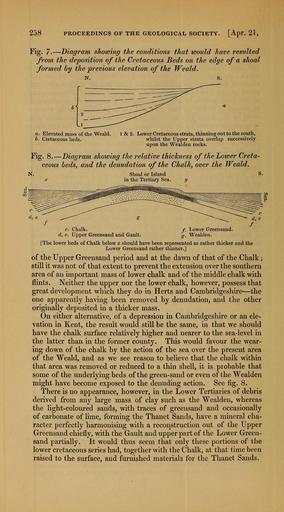MAKE A MEME
View Large Image

| View Original: | The_Quarterly_journal_of_the_Geological_Society_of_London_(12684399623).jpg (1773x3200) | |||
| Download: | Original | Medium | Small | Thumb |
| Courtesy of: | commons.wikimedia.org | More Like This | ||
| Keywords: The Quarterly journal of the Geological Society of London (12684399623).jpg 258 <br> PROCEEDINGS OF THE GEOLOGICAL SOCIETY Apr 21 <br> Fig 7 Diagram showing the conditions that would have resulted <br> from the deposition of the Cretaceous Beds on the edge of a shoal <br> formed by the previous elevation of the Weald <br> N S <br> Elevated mass of the Weald <br> Cretaceous beds <br> 1 2 Lower Cretaceous strata thinning out to the south <br> whilst the Upper strata overlap successively <br> upon the Wealden rocks <br> Fig 8 Diagram showing the relative thickness of the Lower Creta- <br> ceous beds and the denudation of the Chalk over the Weald <br> N Shoal or Island S <br> in the Tertiary Sea <br> c Chalk <br> d e Upper Greensand and Gault <br> / liower Greensand <br> g Wealden <br> The lower beds of Chalk below x should have been represented as rather thicker and the <br> Lower Greensand rather thinner <br> of the Upper Greensand period and at the dawn of that of the Chalk ; <br> still it was not of that extent to prevent the extension over the southern <br> area of an important mass of lower chalk and of the middle chalk with <br> flints Neither the upper nor the lower chalk however possess that <br> great development which they do in Herts and Cambridgeshire' the <br> one apparently having been removed by denudation and the other <br> originally deposited in a thicker mass <br> On either alternative of a depression in Cambridgeshire or an ele- <br> vation in Kent the result would still be the same in that we should <br> have the chalk surface relatively higher and nearer to the sea-level in <br> the latter than in the former county This would favour the wear- <br> ing down of the chalk by the action of the sea over the present area <br> of the Weald and as we see reason to believe that the chalk within <br> that area was removed or reduced to a thin shell it is probable that <br> some of the underlying beds of the green-sand or even of the Wealden <br> might have become exposed to the denuding action See fig 8 <br> There is no appearance however in the Lower Tertiaries of debris <br> derived from any large mass of clay such as the Wealden whereas <br> the light-coloured sands with traces of greensand and occasionally <br> of carbonate of lime forming the Thanet Sands have a mineral cha- <br> racter perfectly harmonising with a reconstruction out of the Upper <br> Greensand chiefly with the Gault and upper part of the Lower Green- <br> sand partially It would thus seem that only these portions of the <br> lower cretaceous series had together with the Chalk at that time been <br> raised to the surface and furnished materials for the Thanet Sands 35461306 109911 51125 Page 258 Text v 8 http //www biodiversitylibrary org/page/35461306 1852 Geological Society of London Biodiversity Heritage Library The Quarterly journal of the Geological Society of London v 8 1852 Geology Periodicals Smithsonian Libraries bhl page 35461306 dc identifier http //biodiversitylibrary org/page/35461306 smithsonian libraries Information field Flickr posted date ISOdate 2014-02-21 Check categories 2015 August 26 CC-BY-2 0 BioDivLibrary https //flickr com/photos/61021753 N02/12684399623 2015-08-27 13 00 50 cc-by-2 0 PD-old-70-1923 The Quarterly journal of the Geological Society of London 1852 Photos uploaded from Flickr by FĂŚ using a script | ||||